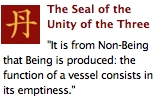Laozi zhongjing (Central Scripture of Laozi)
With the Huangting jing (Scripture of the Yellow Court), the Laozi zhongjing 老子中經 (Central Scripture of Laozi) is the main early text devoted to meditation practices on the inner gods. Most scholars agree in dating this work to the early 3rd century. It contains descriptions of loci of the inner body, visualizations to be performed on certain days and hours, and invocations addressed to the inner and outer gods. These practices are combined with the visualization of nutritive essences that adepts circulate through the body and deliver to the gods in the five viscera, the three Cinnabar Fields, and other inner organs and loci. The speaker of the text is the deified Laozi.
The Lord of the Dao (Daojun 道君)
The Lord of the Dao is the One (Yi). He is the Emperor on High of the August Heaven (Huangtian shangdi) and is the central star of the Northern Asterism of the Central Ultimate (zhongji beichen). He resides above the Nine Heavens, ten thousand zhang on high, within the Palace of the Purple Chamber (Zifang gong) in the Great Abyss (taiyuan). He is clothed in five-colored garments and wears the Headgear of the Nine Virtues (jiude zhi guan). Above him is the five-colored glow of the cloudy pneumas of Great Clarity. Underneath a nine-layered flowery canopy, Laozi and [the Lord of] Great Harmony attend upon him at his left and his right.
![]() Laozi zhongjing (Central Scripture of Laozi), sec. 5. Translation published in Fabrizio Pregadio, "Early Daoist Meditation and the Origins of Inner Alchemy," in Benjamin Penny, ed., Daoism in History: Essays in Honour of Liu Ts'un-yan, 122 (London: Routledge, 2006).
Laozi zhongjing (Central Scripture of Laozi), sec. 5. Translation published in Fabrizio Pregadio, "Early Daoist Meditation and the Origins of Inner Alchemy," in Benjamin Penny, ed., Daoism in History: Essays in Honour of Liu Ts'un-yan, 122 (London: Routledge, 2006).
The Red Child (Chizi 赤子)
The self is the son of the Dao; this is what he is. Human beings also have him, not only me.(1) He resides precisely in the ducts of the stomach, the Great Granary. He sits facing due south on a couch of jade and pearls, and a flowery canopy of yellow clouds covers him. He wears clothes with pearls of five hues. His mother resides above on his right, embracing and nourishing him; his father resides above on his left, instructing and defending him.
Therefore constantly think of the True Man Child-Cinnabar residing in the Palace of the stomach, the Great Granary. He sits facing due south, feeding on yellow essence and red pneuma, drinking and ingesting the Fount of Nectar.(2)
Child-Cinnabar, Original Yang, is nine tenths of an inch tall, but think of him as equal to your body. When his father and mother nourish him, you obtain divine immortality.
(1) The initial part of this passage defies a proper translation, for Laozi (the speaker of the Central Scripture) refers to himself in both the first and the third person. He introduces himself as "I" (wu) and says that he resides in every human being ("human beings also have me," i.e., "him"); he is, therefore, one's own "self" (wu) represented by the Red Child.
(2) Fount of Nectar is a name of saliva.
![]() Laozi zhongjing (Central Scripture of Laozi), sec. 12. Translation published in Fabrizio Pregadio, "Early Daoist Meditation and the Origins of Inner Alchemy," in Benjamin Penny, ed., Daoism in History: Essays in Honour of Liu Ts'un-yan, 138 (London: Routledge, 2006). This quotation is expanded.
Laozi zhongjing (Central Scripture of Laozi), sec. 12. Translation published in Fabrizio Pregadio, "Early Daoist Meditation and the Origins of Inner Alchemy," in Benjamin Penny, ed., Daoism in History: Essays in Honour of Liu Ts'un-yan, 138 (London: Routledge, 2006). This quotation is expanded.
The Lower Cinnabar Field (Dantian 丹田)
The ☞ Cinnabar Field is the root of the human being. It is the place where essence and spirit are stored, the origin of the five breaths (wuqi), and the Storehouse of the Red Child (chizi zhi fu). Men store in it their semen, and women their menstrual blood. It rules on generating children and is the gate of the joining of Yin and Yang. It is three inches below the navel, attached to the Caudal Funnel (weilü),(1) and is the root of the two kidneys. Within the Cinnabar Field the center is red, the left is green, the right is yellow, above is white, and below is black. It is within a space that measures four inches, square (like Earth) and round (like Heaven).(2)
(1) The Caudal Funnel is a point at the level of the coccyx.
(2) This passage ends by stating that the god of the lower Cinnabar Field "has the surname Kong, the name Qiu, and the style Zhongni." The god of this locus of the body is, therefore, none other than Confucius himself.
![]() Laozi zhongjing (Central Scripture of Laozi), sec. 17. Translation published in Fabrizio Pregadio, "Early Daoist Meditation and the Origins of Inner Alchemy," in Benjamin Penny, ed., Daoism in History: Essays in Honour of Liu Ts'un-yan, 139-40 (London: Routledge, 2006).
Laozi zhongjing (Central Scripture of Laozi), sec. 17. Translation published in Fabrizio Pregadio, "Early Daoist Meditation and the Origins of Inner Alchemy," in Benjamin Penny, ed., Daoism in History: Essays in Honour of Liu Ts'un-yan, 139-40 (London: Routledge, 2006).




